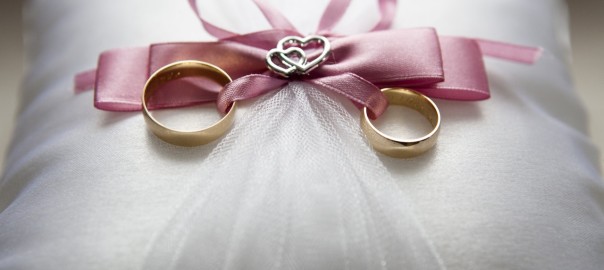Gold Wedding Rings – How to Choose

Traditionally, when we think of gold, we immediately go to the popularized images of the Gold Rush – miners digging in the riverbed, sifting out yellow gold deposits and then biting the gold. However, when you purchase gold jewelry, gold wedding rings, wedding bands and gold watches, they’ll almost never be soft enough to bite down to leave an impression.
Gold is measured in karats (with a “k”) and indicates the purity of gold, with 24k being pure. Pure gold is very soft and malleable which is why gold jewelry is created in 10K, 14K and 18K. When you have anything less than 24K gold, other alloys like copper, palladium, silver or nickel have been added to strengthen the metal overall. When you hear gold-plated, often the jewelry is silver with gold plating over it, which typically rubs off over time.

Gold Wedding Rings – Different Colors
So, what about gold in different colors? Generally, when you hear the word “gold” most people think of yellow gold. However, as we mentioned before, yellow gold in jewelry is not pure 24k. For example, with 18K yellow gold, the mix is 75% pure gold and varying amounts of silver and copper. Depending on the hue of gold (yellow, white and rose) and the karat weight, will determine the proper mix of gold and other certain metals.
When looking at the three basic gold colors – yellow, white and rose – there are benefits and drawbacks to all three:
- Yellow gold is the most common, and least hypoallergenic. However it is the most prone, of the three, to scratches and dents due to the other 25% of its make-up.
- White gold, because of its composition, is often stronger than yellow gold, and sometimes a bit more expensive because it contains silver or nickel, and palladium. However, jewelers will rhodium plate white gold to retain the whiteness of a ring. Just like gold plated jewelry, rhodium will wear off over time. When this happens, simply bring in your item(s) to be rhodium or gold plated at your local jeweler. Another important element to talk about is “nickel”, and with some people it causes an allergic reaction.
- Rose gold (or red gold), is one of the more popular metal choices for engagement rings currently. Not only does the rose hue look great on most skin-tones, it’s also very affordable and durable due to the amount of copper present. But just like nickel, some people are allergic to copper too.
Non-Gold Wedding Rings
So what is metal another option if you are allergic to nickel and copper, and want a “white” gold ring? Jewelry made of platinum. As a matter of fact, many people choose platinum engagement rings because of their hypoallergenic properties, and because it shows a more “pure” white appearance. Platinum jewelry is more expensive because it’s a rarer metal than gold, and more durable. Although it weighs more and can scratch easily, the upside is your jeweler can “buff” the scratches out without changing the hue, as if it were gold or gold plated.
Did you know there are three more branded types of gold on the market? Well, you just might stumble across them when searching for high-end luxury watches. These gold types are:
- King Gold, branded by Hublot, as an 18k red gold that is even redder than red gold due to the presence of platinum and high levels of copper.
- Magic Gold, also branded by Hublot, mixes ceramic into its 18k composition to make it more scratch resistance.
- Lastly, Everose, similar to that of Hublot, but developed and patented by Rolex. Everose gold uses platinum instead of silver which gives a lasting Everose hue for years to come.
So when selecting jewelry or an engagement ring, it’s important to consider budget somewhat, but allergies, skin tone, personal taste, and lifestyle. At Schwanke-Kasten Jewelers, we pride ourselves being able to assist our customers in selecting the perfect gift for any occasion.
 morning seem to find more than a few wedding and engagement rings in the sand and surf. It’s very important to notice the fit of your ring at all times. Have you lost weight recently? Have you been working with slippery substances like, for example, suntan lotion?
morning seem to find more than a few wedding and engagement rings in the sand and surf. It’s very important to notice the fit of your ring at all times. Have you lost weight recently? Have you been working with slippery substances like, for example, suntan lotion?